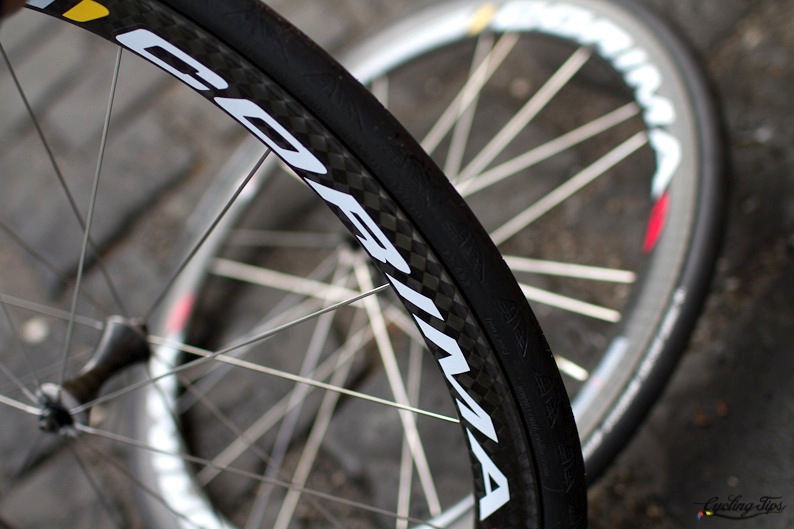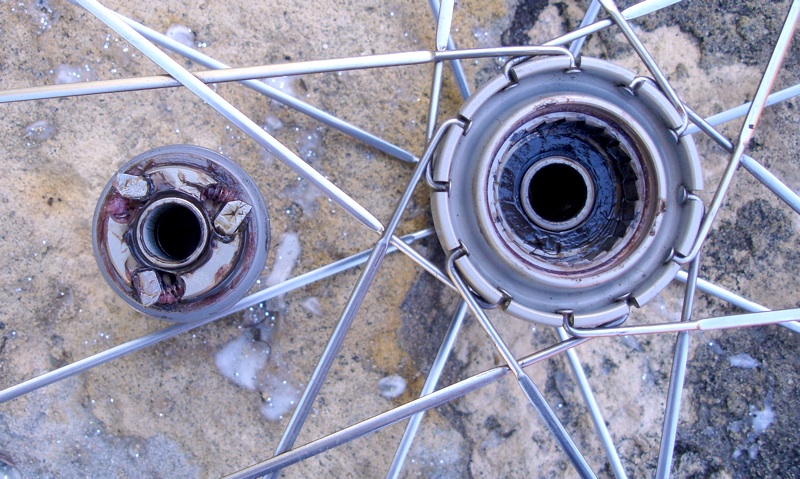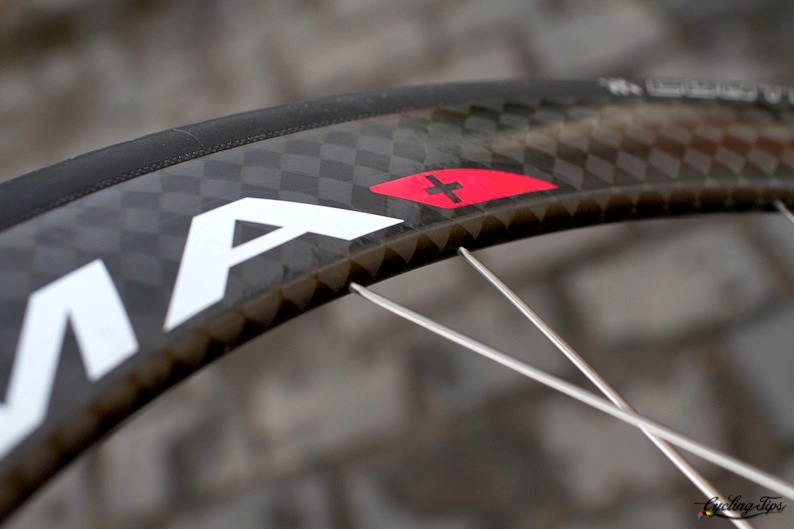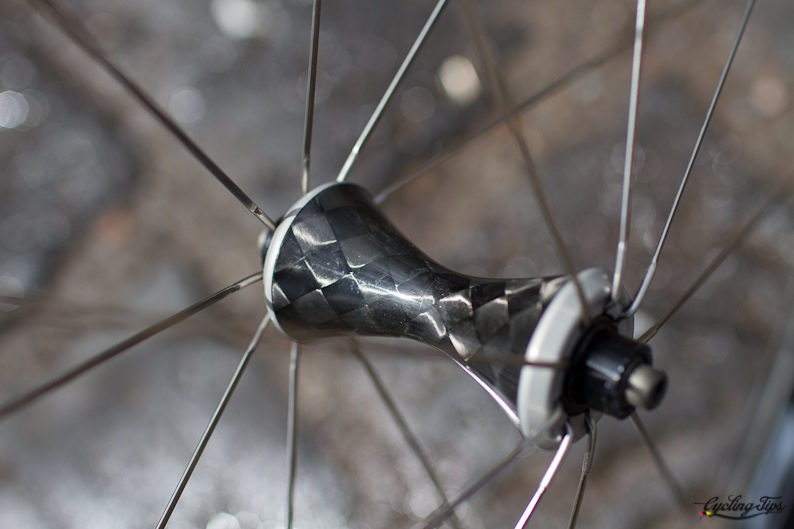Corima Aero+ wheels feature a 45mm tall rim with internal nipples, 18 spokes up front and 20 spokes in the rear. The rear hub features an interchangeable body for Shimano and Campagnolo cassettes, and the wheelset weighs in at a little over 1300g and 1500g for tubulars and clinchers, respectively. You can expect to pay around $2100 to get a set of these wheels on your bike.
Before the ride
I’ve already written at length on the pros and cons of factory wheelsets, and one of the biggest cons for me is the use of proprietary spokes. When the Corima Aero+ wheels arrived for review, one of the first things to catch my eye was the spokes: standard j-bend spokes are used throughout the wheelset. Better yet, they are Sapim CX-RAY spokes, which have a solid reputation for their strength, aerodynamics, and weight. Curiously, Corima have opted to lace the rear wheel with CX spokes, which are wider, heavy, and not as strong as CX-RAY spokes. Radial lacing is used for the front wheel and non-drive side of the rear wheel; 3-cross lacing is used for the drive side.

Simple yet striking graphics coupled with a very distinctive carbon weave make for an attractive wheelset
The engineers at Corima decided on slots, rather than holes, for securing the heads of the spokes. I couldn’t find out what the flanges are made of but it appears to be some kind of resin or plastic-I’ve no reason to doubt the resilience of this material, but I did find myself wondering about the durability of this design.
The hub internals are simple and straightforward to disassemble and service, just couple of 15mm cone spanners is all you need. There are three pawls in the freehub mounted on individual springs. Cartridge bearings are used throughout the hubs, but I was a little disappointed that there was no locking mechanism on the adjusting cones. I prefer locking off the bearing pre-load so I never have to worry about play in my hubs. One last note on the freehub: the Shimano pattern incorporates taller spines that are compatible with newer Shimano cassettes that have alloy carriers (ie 105 and above), but not SRAM red or cheaper/older Shimano cassettes lacking carriers.

A quick look inside the rear hub: once the cones have been removed, the axle and freehub slide out from the hub with very little effort
I found the hub spacing to be a little off on our test wheels, 1-2mm narrower for both the front and rear, but it was enough to cause noticeable pinching of my fork blades. At the very least, the narrower spacing will make fast wheel changes difficult. The quick release skewers supplied with the wheels were effective but unremarkable in every other respect.
The clincher rims appeared uniform and robust, no blemishes or imperfections along the braking track or the bed of the rim. The spoke nipples are hidden within the rim and easily adjusted-but only after you take the tire and rim tape off and grab a specific tool, a major inconvenience. I never mind truing wheels on the bikes I service unless they have internal nipples, then I do a quick cost-benefit analysis to decide if the extra trouble is really worth it.
As supplied, the Aero+ wheels come with wheel bags and cork brake pads. As a nice touch, pad inserts are provided for both Shimano-style and Campagnolo brakesets.
After the ride
The Aero+ wheelset looks sensational, the deep rims, the carbon weave, and the simple yet dynamic graphics all work to turn a road bike into a race bike. I was already feeling faster before I turned a pedal over. Better yet, an hour down the road and the wheels were delivering on their promise of speed.
The rims are light and defy their depth to some degree. Every turn of the crank felt a little easier, regardless of whether I was riding on a flat road or climbing a hill. I was anticipating a fair bit of trouble with these wheels in the wind, and while crosswinds definitely pushed the wheels around, I only ever needed to make minor corrections to maintain a straight line. All told, they behaved predictably in the wind.
These wheels roll nicely; they don’t suffer any unnecessary drag and wind down slowly. They provide a very comfortable ride on all but the harshest of road surfaces, at which point they transferred a considerable amount of road buzz that seemed out of proportion to the quality of the road. Even at these moments, the wheels rolled on with barely any noise. They still deliver some of the distinctive carbon wheel rumble when the bike is swayed from side-to-side, but they allow for some stealth before you launch an attack. Out of the saddle, I found the wheels to be stiff, but not unyielding, firm but not unforgiving. Corima markets this wheelset as a versatile performer and I have to agree.
I didn’t get to test Corima’s cork brake pads with the wheels but I found that Swissstop’s yellow pads were quite effective. Braking performance is generally poor when comparing carbon with alloy rims and that axiom applies to the Aero+ wheelset: at best, braking slows you down, but it doesn’t stop you.
Final thoughts
In discussing the value of these wheels with my riding buddies, I found it hard to convince them that they were worth the extra expense. All agreed that the wheels look fantastic and made my bike look faster, but out on the road, the benefits were less obvious. I couldn’t pull away from my mate who was riding Fulcrum Racing Zeros when rolling down a hill, and I couldn’t topple my best time on my 10km time trial course. However, thanks to the light Aero+ rims, I found that the pedals were easier to turn over every time I was on the bike, so perhaps all the gains I made were in efficiency rather than speed. Better yet, I felt like I could go faster, and in this regard, Corima has delivered a fine product. Rather than consider all the other carbon wheels on the market, I’ll leave you with this thought: Are the tubular version of the Aero+ wheelset is a better buy? With a weight saving of over 200g when compared to the clinchers and a $300 saving on the asking price, they might be a good consideration.
[CT] Full disclosure: CellBikes.com advertise on CyclingTips and the Corima Aero Plus wheelsets can be found on their website.




